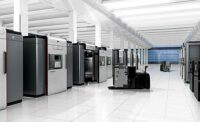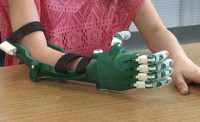CAMBRIDGE, England—Additive manufacturing offers numerous benefits for electric vehicle manufacturers. However, the technology also presents numerous challenges to engineers.
A recent report by IDTechEx examines the opportunities and barriers to printing EV components. After conducting interviews with key printer manufacturers and material suppliers, the research firm identified five opportunities:
• Lightweighting. Additive manufacturing can assist with the lightweighting of parts, which can extend an EV's driving range and create room for other components, such as larger batteries.
• Simplification of manufacturing. Additive manufacturing could allow for large assemblies to be consolidated into fewer parts, potentially allowing for a simplified supply chain and cost reductions.
• Improving speed to market. Additive manufacturing assists in reducing design cycle times by cutting production times and costs for prototyping and tooling. With vehicle design cycles shortening, 3D-printed parts could assist in bringing EVs to market faster through the production of prototypes (both aesthetic and functional) and tooling.
• Changes in legacy automotive supply chains. As legacy parts such as gas tanks are switched out for EV-specific ones, such as batteries, automakers and suppliers will be creating new supply chains to accommodate these new parts. This may leave room for additive manufacturing to take up market share, especially if manufacturers are more willing to consider alternative technologies as they adjust their supply chains.
• Flexibility in emerging EV players. The EV market has numerous startups that are more willing to consider alternative production technologies like additive manufacturing compared to legacy automakers. These startups may be more interested in digital supply chain dynamics than traditional players with long-standing supply chains.
However, IDTechEx analysts warn that there are six barriers facing 3D printing's application in electric vehicles:
• High cost of additive manufacturing. Most printed parts cannot compete price-wise against traditionally machined, cast or molded parts. It will be challenging to find applications where the performance benefits of additive manufacturing justify the cost, especially considering the need to bring the cost of EVs down to increase mass-market adoption.
• Limited materials portfolio and sources. Most additive manufacturing technologies do not yet process the aluminum and steel alloys alloys commonly used by automotive OEMs.
• Bias toward established methods and supply chains. There is bias toward traditional machining and molding techniques, especially among engineers at traditional automakers. In addition, these companies have long-established supply chains. With how risk-averse OEMs can be, it is difficult to introduce new manufacturing technologies like additive manufacturing.
• Production throughput is too low for mass-market adoption. Additive manufacturing has lower throughput than established manufacturing processes, making it hard to achieve high-volume production for mass-market EVs.
• Lack of need for performance improvements. For many mass-market parts, current solutions perform well enough, so there is no need for OEMs to adopt additivie manufacturing for production-ready parts.
• Lack of reliability. With OEMs being quite risk-averse, additive manufacturing needs to prove its quality and consistency to be used for mass-market EVs.




